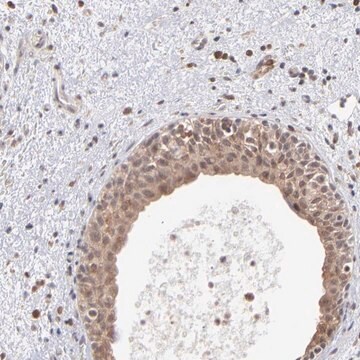MABC943
Anti-OAS1 Antibody, clone 1D11.1
clone 1D11.1, from mouse
Sinônimo(s):
2′-5′-oligoadenylate synthase 1, (2-5′)oligo(A) synthase 1, 2-5A synthase 1, E18/E16, p46/p42 OAS
About This Item
Produtos recomendados
fonte biológica
mouse
Nível de qualidade
forma do anticorpo
purified antibody
tipo de produto de anticorpo
primary antibodies
clone
1D11.1, monoclonal
reatividade de espécies
human
técnica(s)
western blot: suitable
Isotipo
IgG2aκ
nº de adesão NCBI
nº de adesão UniProt
modificação pós-traducional do alvo
unmodified
Informações sobre genes
human ... OAS1(4938)
Descrição geral
Especificidade
Imunogênio
Aplicação
Apoptosis & Cancer
RNA Metabolism & Binding Proteins
Qualidade
Western Blotting Analysis: A 1:500 dilution of this antibody detected OAS1 in 10 µg of lysate from IFN gamma-treated HeLa cells.
Descrição-alvo
forma física
Armazenamento e estabilidade
Outras notas
Exoneração de responsabilidade
Not finding the right product?
Try our Ferramenta de seleção de produtos.
Código de classe de armazenamento
12 - Non Combustible Liquids
Classe de risco de água (WGK)
WGK 1
Ponto de fulgor (°F)
Not applicable
Ponto de fulgor (°C)
Not applicable
Certificados de análise (COA)
Busque Certificados de análise (COA) digitando o Número do Lote do produto. Os números de lote e remessa podem ser encontrados no rótulo de um produto após a palavra “Lot” ou “Batch”.
Já possui este produto?
Encontre a documentação dos produtos que você adquiriu recentemente na biblioteca de documentos.
Nossa equipe de cientistas tem experiência em todas as áreas de pesquisa, incluindo Life Sciences, ciência de materiais, síntese química, cromatografia, química analítica e muitas outras.
Entre em contato com a assistência técnica







